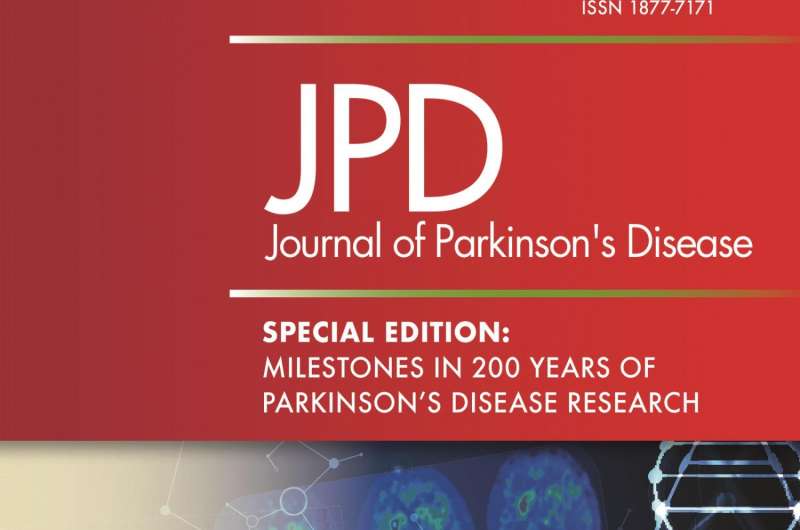Journal of Parkinson's Disease celebrates key breakthroughs

Marking the 200th anniversary of James Parkinson's first published description of the disease that would come to bear his name, the Journal of Parkinson's Disease is proud to publish Milestones in 200 Years of Parkinson's Disease Research. This special issue features commentaries by luminaries in the field, who are responsible for some of the greatest advances in understanding and treating the disease since it was first characterized. The issue is openly available as a service to the Parkinson's disease (PD) community.
"We are indeed fortunate to have contributions from many of those who played key roles in reaching these milestones in PD research," remarked Patrik Brundin, MD, PhD, Associate Director of Research, Professor and Director of the Center for Neurodegenerative Science, Van Andel Research Institute, Grand Rapids, MI, and Co-Editor-in-Chief of the Journal of Parkinson's Disease. "These engaging first-hand accounts describe how these advances came about and their lasting impact, with the advantage of hindsight."
"This remarkable collection of articles by those who helped shape our current understanding of Parkinson's disease is unlikely to be repeated anytime soon. And each paper has an inside look at how the research was done, and in many cases what inspired it. What a great way to celebrate the 200th anniversary of James Parkinson's original publication describing the disease which now bears his name," added J. William Langston, MD, Chief Scientific Officer and Founder of the Parkinson's Institute and Clinical Center, Sunnyvale, CA, and Co-Editor-in-Chief of the Journal of Parkinson's Disease.
The issue focuses on these groundbreaking achievements in the battle against PD:
L-DOPA by Oleh Hornykiewicz relates the remarkable mixture of science, intrigue, and politics behind his work in the 1950s and early 1960s that triggered the modern era of Parkinson's disease research: the discovery of the dopamine deficit in the brain of patients with Parkinson's.
In The MPTP Story, J. William Langston describes the fascinating string of events in the 1980s that led to his discovery of the toxic effects of MPTP on nigral dopamine neurons. This provided early insights into the possibility that mitochondrial dysfunction and oxidative stress could be important players in disease pathogenesis.
Replacing Dopamine Neurons in Parkinson's Disease: How Did It Happen? by Anders Björklund and Olle Lindvall recounts their pioneering cell transplantation studies aimed at replacing dopaminergic neurons in Parkinson's patients.
Marwan Hariz provides a scholarly and lively account that chronicles the birth of deep brain stimulation (DBS) targeting the subthalamic nucleus for treatment of symptoms of PD in My 25 Stimulating Years with DBS in Parkinson's Disease. This advancement was described by C. David Marsden, widely acknowledged as one of the leading authorities on PD, as the most important discovery since levodopa and its evolution up to the present day.
Robert L. Nussbaum tells the exciting story of his identification of the first mutations in the alpha-synuclein gene that cause rare forms of hereditary PD in The Identification of Alpha-Synuclein as the First Parkinson Disease Gene.
The Synucleinopathies: Twenty Years On focuses on the enormous implications of synucleinopathies following the discovery by Michel Goedert, Ross Jakes, and Maria Grazia Spillantini that the Lewy bodies from patients with the more common sporadic form of the disease are largely made up of aggregated alpha-synuclein.
In Neuropathological Staging of Brain Pathology in Sporadic Parkinson's Disease: Separating the Wheat from the Chaff, Heiko Braak and Kelly Del Tredici share a compelling report on the controversy that surrounded the development of the landmark six-stage model for brain Lewy body pathology related to sporadic PD.
Andrew B Singleton, John A Hardy, and Thomas Gasser describe how the list of mutations associated with PD was impressively extended this century in The Birth of the Modern Era of Parkinson's Disease Genetics.
Commenting on how the course of PD research can sometimes proceed in unexpected directions, Robert L. Nussbaum, MD, Chief Medical Officer, Invitae Corporation, and former Holly Smith Professor, University of California San Francisco, said, "The discovery of alpha-synuclein as a key component of sporadic, typical Parkinson disease was the result of research that flowed from a desire to understand the cause of a rare hereditary form of the disease that was initially dismissed by the PD research community as not being relevant to the common form of the disease. It underscores how important it is not to be too narrow or focused in asking research questions and instead to foster basic, curiosity-driven research in many fields, because you can never predict where important breakthroughs might come from."
Advancements in PD research have been substantial and paved the way for future breakthroughs in understanding the underlying science and translational medicine that can be applied to clinical practice to improve patient care and quality of life. "One might foresee that 10 years from now we will be able describe research on how to accurately predict who will develop PD, and that it will be possible to use precision medicine to define distinct subtypes of the disease," speculated Dr. Brundin." Furthermore, given the pace of recent discoveries, we hope that our 210th year commemorative issue will describe treatments that slow Parkinson's disease progression, which are glaringly absent from the first 200 years of Parkinson's research. What is certain, is that the milestones described in this issue form the foundations upon which such a treatment will be built."



















